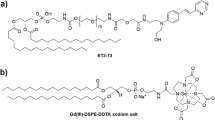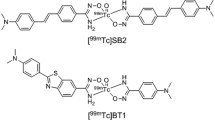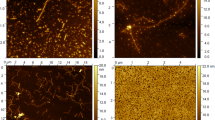ABSTRACT
Purpose
The lack of an in vivo diagnostic test for AD has prompted the targeting of amyloid plaques with diagnostic imaging probes. We describe the development of a contrast agent (CA) for magnetic resonance microimaging that utilizes the F(ab′)2 fragment of a monoclonal antibody raised against fibrillar human Aβ42
Methods
This fragment is polyamine modified to enhance its BBB permeability and its ability to bind to amyloid plaques. It is also conjugated with a chelator and gadolinium for subsequent imaging of individual amyloid plaques
Results
Pharmacokinetic studies demonstrated this 125I-CA has higher BBB permeability and lower accumulation in the liver and kidney than F(ab′)2 in WT mice. The CA retains its ability to bind Aβ40/42 monomers/fibrils and also binds to amyloid plaques in sections of AD mouse brain. Intravenous injection of 125I-CA into the AD mouse demonstrates targeting of amyloid plaques throughout the cortex/hippocampus as detected by emulsion autoradiography. Incubation of AD mouse brain slices in vitro with this CA resulted in selective enhancement on T 1-weighted spin-echo images, which co-register with individual plaques observed on spatially matched T 2-weighted spin-echo image
Conclusions
Development of such a molecular probe is expected to open new avenues for the diagnosis of AD.






Similar content being viewed by others
REFERENCES
D. J. Selkoe. Clearing the brain’s amyloid cobwebs. Neuron. 32:177–180 (2001).
W. E. Klunk, H. Engler, A. Nordberg, Y. M. Wang, G. Blomqvist, D. P. Holt, M. Bergstrom, I. Savitcheva, G. F. Huang, S. Estrada, B. Ausen, M. L. Debnath, J. Barletta, J. C. Price, J. Sandell, B. J. Lopresti, A. Wall, P. Koivisto, G. Antoni, C. A. Mathis, and B. Langstrom. Imaging brain amyloid in Alzheimer’s disease with Pittsburgh Compound-B. Ann. Neurol. 55:306–319 (2004).
N. P. Verhoeff, A. A. Wilson, S. Takeshita, L. Trop, D. Hussey, K. Singh, H. F. Kung, M. P. Kung, and S. Houle. In-vivo imaging of Alzheimer disease beta-amyloid with [11C]SB-13 PET. Am. J. Geriatr. Psychiatry. 12:584–595 (2004).
G. W. Small, V. Kepe, L. M. Ercoli, P. Siddarth, S. Y. Bookheimer, K. J. Miller, H. Lavretsky, A.C. Burggren, G.M. Cole, H.V. Vinters, P.M. Thompson, S.C. Huang, N. Satyamurthy, M.E. Phelps, and J.R. Barrio. PET of brain amyloid and tau in mild cognitive impairment. N. Engl. J. Med. 355:2652–2663 (2006).
C. R. Jack, T. M. Wengenack, D. A. Reyes, M. Garwood, G. L. Curran, B. J. Borowski, J. Lin, G. M. Preboske, S. S. Holasek, G. Adriany, and J. F. Poduslo. In vivo magnetic resonance microimaging of individual amyloid plaques in Alzheimer’s transgenic mice. J. Neurosci. 25:10041–10048 (2005).
J. F. Poduslo, T. M. Wengenack, G. L. Curran, T. Wisniewski, E. M. Sigurdsson, S. I. Macura, B. J. Borowski, and C. R. Jr Jack. Molecular targeting of Alzheimer’s amyloid plaques for contrast-enhanced magnetic resonance imaging. Neurobiol. Dis. 11:315–329 (2002).
Y. Z. Wadghiri, E. M. Sigurdsson, M. Sadowski, J. I. Elliott, Y. S. Li, H. Scholtzova, C. Y. Tang, G. Aguinaldo, M. Pappolla, K. Duff, T. Wisniewski, and D. H. Turnbull. Detection of Alzheimer’s amyloid in Transgenic mice using magnetic resonance microimaging. Magn. Reson. Med. 50:293–302 (2003).
H. Benveniste, G. Einstein, K. R. Kim, C. Hulette, and G. A. Johnson. Detection of neuritic plaques in Alzheimer’s disease by magnetic resonance microscopy. Proc Natl Acad Sci U S A. 96:14079–14084 (1999).
J. A. Helpern, S. P. Lee, M. F. Falangola, V. V. Dyakin, A. Bogart, B. Ardekani, K. Duff, C. Branch, T. Wisniewski, M. J. de Leon, O. Wolf, J. O’Shea, and R. A. Nixon. MRI assessment of neuropathology in a transgenic mouse model of Alzheimer’s disease. Magn. Reson. Med. 51:794–798 (2004).
G. Vanhoutte, I. Dewachter, P. Borghgraef, F. Van Leuven, and A. Van der Linden. Noninvasive in vivo MRI detection of neuritic plaques associated with iron in APP[V717I] transgenic mice, a model for Alzheimer’s disease. Magn Reson Med. 53:607–613 (2005).
C. R. Jr Jack, M. Garwood, T. M. Wengenack, B. Borowski, G. L. Curran, J. Lin, G. Adriany, O. H. Grohn, R. Grimm, and J. F. Poduslo. In vivo visualization of Alzheimer’s amyloid plaques by magnetic resonance imaging in transgenic mice without a contrast agent. Magn. Reson. Med. 52:1263–1271 (2004).
J. F. Poduslo, G. L. Curran, and C. T. Berg. Macromolecular Permeability across the Blood–Nerve and Blood–Brain Barriers. Proc. Natl. Acad. Sci. U S A. 91:5705–5709 (1994).
J. F. Poduslo, and G. L. Curran. Amyloid beta peptide as a vaccine for Alzheimer’s disease involves receptor-mediated transport at the blood–brain barrier. Neuroreport. 12:3197–3200 (2001).
J. F. Poduslo, M. Ramakrishnan, S. S. Holasek, M. Ramirez-Alvarado, K. K. Kandimalla, E. J. Gilles, G. L. Curran, and T. M. Wengenack. In vivo targeting of antibody fragments to the nervous system for Alzheimer’s disease immunotherapy and molecular imaging of amyloid plaques. J. Neurochem. 102:420–433 (2007).
L. Holcomb, M. N. Gordon, E. McGowan, X. Yu, S. Benkovic, P. Jantzen, K. Wright, I. Saad, R. Mueller, D. Morgan, S. Sanders, C. Zehr, K. O’Campo, J. Hardy, C. M. Prada, C. Eckman, S. Younkin, K. Hsiao, and K. Duff. Accelerated Alzheimer-type phenotype in transgenic mice carrying both mutant amyloid precursor protein and presenilin 1 transgenes. Nature Med. 4:97–100 (1998).
K. Hsiao, P. Chapman, S. Nilsen, C. Eckman, Y. Harigaya, S. Younkin, F. S. Yang, and G. Cole. Correlative memory deficits, A beta elevation, and amyloid plaques in transgenic mice. Science. 274:99–102 (1996).
P. M. Smith-Jonesand, and D. B. Solit. Generation of DOTA-conjugated antibody fragments for radioimmunoimaging. Methods Enzymol. 386:262–275 (2004).
U. K. Laemmli. Cleavage of structural proteins during the assembly of the head of bacteriophage T4. Nature. 227:680–685 (1970).
J. F. Poduslo, G. L. Curran, T. M. Wengenack, B. Malester, and K. Duff. Permeability of proteins at the blood–brain barrier in the normal adult mouse and double transgenic mouse model of Alzheimer’s disease. Neurobiology of Disease. 8:555–567 (2001).
J. B. Bassingthwaighte, F. P. Chinard, C. Crone, C. A. Goresky, N. A. Lassen, R. S. Reneman, and K. L. Zierler. Terminology for mass transport and exchange. Am. J. Physiol. 250:H539–545 (1986).
J. F. Poduslo, G. L. Curran, T. M. Wengenack, B. Malester, and K. Duff. Permeability of proteins at the blood–brain barrier in the normal adult mouse and double transgenic mouse model of Alzheimer’s disease. Neurobiol Dis. 8:555–567 (2001).
J. F. Poduslo, G. L. Curran, J. A. Peterson, D. J. McCormick, A. H. Fauq, M. A. Khan, and T. M. Wengenack. Design and chemical synthesis of a magnetic resonance contrast agent with enhanced in vitro binding, high blood–brain barrier permeability, and in vivo targeting to Alzheimer’s disease amyloid plaques. Biochem. 43:6064–6075 (2004).
R. A. Robb. A software system for interactive and quantitative analysis of biomedical images. In K. H. F. Hohne, and S. M. Pizer (eds.), 3D Imaging in Medicine. Springer, Berlin, 1990, pp. 333–361.
M. Marjanska, G. L. Curran, T. M. Wengenack, P. G. Henry, R. L. Bliss, J. F. Poduslo, C. R. Jr Jack, K. Ugurbil, and M. Garwood. Monitoring disease progression in transgenic mouse models of Alzheimer’s disease with proton magnetic resonance spectroscopy. Proc. Natl. Acad Sci. U S A. 102:11906–11910 (2005).
C. R. Jr Jack, T. M. Wengenack, D. A. Reyes, M. Garwood, G. L. Curran, B. J. Borowski, J. Lin, G. M. Preboske, S. S. Holasek, G. Adriany, and J. F. Poduslo. In vivo magnetic resonance microimaging of individual amyloid plaques in Alzheimer’s transgenic mice. J. Neurosci. 25:10041–10048 (2005).
Y. Tamura, K. Hamajima, K. Matsui, S. Yanoma, M. Narita, N. Tajima, K. Q. Xin, D. Klinman, and K. Okuda. The F(ab′)2 fragment of an Abeta-specific monoclonal antibody reduces Abeta deposits in the brain. Neurobiol. Dis. 20:541–549 (2005).
P. Bergmann, R. Kacenelenbogen, and A. Vizet. Plasma clearance, tissue distribution and catabolism of cationized albumins with increasing isoelectric points in the rat. Clin Sci (Lond). 67:35–43 (1984).
W. M. Pardridge. Strategies for drug delivery through the blood–brain barrier. Neurobiol Aging. 10:636–637 (1989)(discussion 648–650).
R. E. Majocha, J. M. Reno, R. P. Friedland, C. VanHaight, L. R. Lyle, and C. A. Marotta. Development of a monoclonal antibody specific for beta/A4 amyloid in Alzheimer’s disease brain for application to in vivo imaging of amyloid angiopathy. J. Nucl Med. 33:2184–2189 (1992).
R. P. Friedland, J. Shi, J. C. Lamanna, M. A. Smith, and G. Perry. Prospects for noninvasive imaging of brain amyloid beta in Alzheimer’s disease. Ann. N Y Acad Sci. 903:123–128 (2000).
H. J. Lee, Y. Zhang, C. Zhu, K. Duff, and W. M. Pardridge. Imaging brain amyloid of Alzheimer disease in vivo in transgenic mice with an Abeta peptide radiopharmaceutical. J.Cereb.Blood Flow Metab. 22:223–231 (2002).
P. Kumar, H. Wu, J. L. McBride, K. E. Jung, M. H. Kim, B. L. Davidson, S. K. Lee, P. Shankar, and N. Manjunath. Transvascular delivery of small interfering RNA to the central nervous system. Nature. 448:39–43 (2007).
L. N. Patel, J. L. Zaro, and W.C. Shen. Cell penetrating peptides: intracellular pathways and pharmaceutical perspectives. Pharm Res. 24:1977–1992 (2007).
R.J. Boado, Y. Zhang, C. F. Xia, and W. M. Pardridge. Fusion antibody for Alzheimer’s disease with bidirectional transport across the blood–brain barrier and abeta fibril disaggregation. Bioconjug Chem. 18:447–455 (2007).
ACKNOWLEDGEMENTS
The authors would like to thank Dr. Karen Duff for the PS1 transgenic mouse line, Dawn Gregor for her expert technical assistance, and Dr. Thomas G. Beito and Dr. Chella S. David of the Mayo Monoclonal Core Facility. Thanks to Prof. Shawn Que Hee, director of ICP-MS facility for the ICP-mass spectral analysis. Support was provided by the Neuroscience Cores for MR Studies of the Brain from NINDS (NS057091) and the Minnesota Partnership for Biotechnology and Medical Genomics.
Author information
Authors and Affiliations
Corresponding author
Rights and permissions
About this article
Cite this article
Ramakrishnan, M., Wengenack, T.M., Kandimalla, K.K. et al. Selective Contrast Enhancement of Individual Alzheimer’s Disease Amyloid Plaques Using a Polyamine and Gd-DOTA Conjugated Antibody Fragment Against Fibrillar Aβ42 for Magnetic Resonance Molecular Imaging. Pharm Res 25, 1861–1872 (2008). https://doi.org/10.1007/s11095-008-9600-9
Received:
Accepted:
Published:
Issue Date:
DOI: https://doi.org/10.1007/s11095-008-9600-9




